Abstract
The band structure, density of states, and the Fermi surface of a recently discovered superconductor, oxygen-deficient tungsten oxide WO that is equivalent to WO, is studied within the density functional theory (DFT) in the generalized gradient approximation (GGA). Here we show that despite the extremely complicated structure containing 78 atoms in the unit cell, the low-energy band structure is quite feasible. Fermi level is crossed by no more than 10 bands per one spin projection (and even 9 bands per pseudospin projection when the spin-orbit coupling is considered) originating from the t 5d-orbitals of tungsten atoms forming zigzag chains. These bands become occupied because of the specific zigzag octahedra distortions. To demonstrate the role of distortions, we compare band structures of WO with the real crystal structure and with the idealized one. We also propose a basis for a minimal low-energy tight-binding model for WO.
1. Introduction
The discovery of a new type of superconductor is always exciting since it promotes a novel insight into the understanding of such a basic phenomenon. It is especially evident in the unconventional and high- superconductors such as cuprates [1] and Fe-based materials [2]. Recent discovery of superconductivity in a tungsten oxide WO is not an exception [3]. Structure and electrical properties of tungsten trioxide WO and oxygen-deficient tungsten oxides WO were thoroughly studied quite long ago [4,5]. Tungsten oxides are known for their thermoelectric applications [6] that makes them the distant relatives to the other superconductor, water-intercalated sodium cobaltate NaCoOHO [7,8,9,10]. Another similarity with sodium cobaltates, cuprates, and iron-based materials arise from the partially filled d-orbitals of W involved in the conductivity, i.e., the stoichiometric material WO has an empty d-shell with tungsten W in configuration. Oxygen deficiency induces W ions with the configuration. Observation of superconductivity in twin-walls of WO [11], thin films [12], and in WO with the surface composition NaWO [13] led to the proposal of the possible superconductivity in WO [14] and a consequent discovery of it in WO with K and with K after the lithium intercalation [3] that provides even stronger electron doping.
There are quite a few first-principles studies of WO regarding its electronic structure [15,16], role of oxygen vacancies [17,18,19], and cation doping [20,21,22] (for more references see review [15]) but not as much of Magnéli phases of the tungsten oxide. As far as we know only the work of Migas et al. [23] contains results for the band structure for all Magnéli phases (see Figure 1)), though it does not include effects of the spin-orbit coupling. In that paper, the authors have shown that Magnéli phases of tungsten oxides (WO, WO, WO, WO, WO, WO, and WO) demonstrate the metal-like properties. One of the main features of the band structures is an energy gap of about 1 eV right below the Fermi level. A trend could be traced: the closer the stoichiometry of WO to WO, the smaller the charge carrier concentration. Also, the spin-polarized calculations for the WO phase does not reveal any magnetic moment and it is claimed that this is valid for the other phases [23].
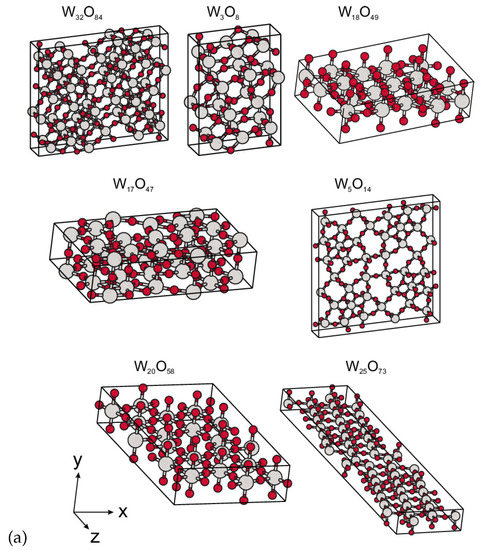
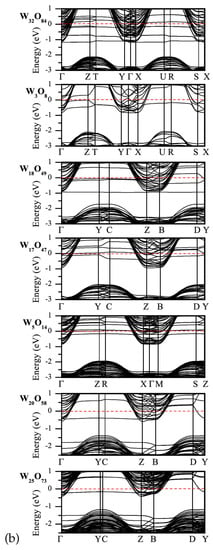
Figure 1.
Crystal structure of Magnéli phases (a) and corresponding band structures (b). Reprinted from [23], with the permission of AIP Publishing, 2010.
Here we take further steps toward the understanding of the WO properties. Specifically, by means of density functional theory (DFT), we explore the orbital composition of bands crossing the Fermi level and give detailed explanation of why exactly these orbitals are occupied. We also discuss the topology of the Fermi surface and the role of the spin-orbit coupling. To see the influence of crystal structure distortions on the band structure, comparison with the idealized crystal structure WO bands is performed. The unit cell of WO contains 78 ions and produces an extremely complicated band structure. We show that one can, however, formulate a rather simple low-energy band model that includes just a few parabolic bands of the and orbital character.
2. Crystal Structure and Calculation Details
W20O58 belongs to the family of the Magnéli-type oxides with the general formulan WnO3n−2 [4]. The space group is a P2/m:b with the unique axis b. The lattice parameters are the following: a = 3.78b = 12.1c = 23.39β = 95° [24]. In Figure 2 we show the W20O58 supercell (2 × 2 × 2).
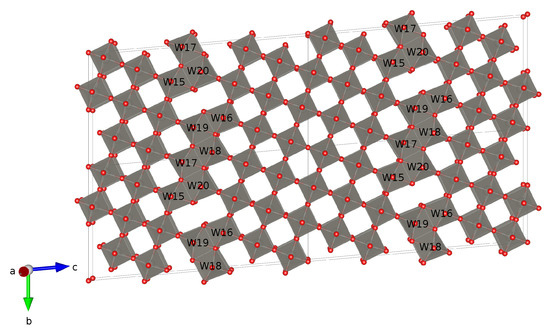
Figure 2.
Crystal structure of the WO supercell. Tungsten atoms located along the zigzag stripes are labeled.
The elementary unit cell is quite large and contains 20 tungsten atoms and 58 oxygens making it a kind of a nano-object. Complexity of WO crystal structure arises from the oxygen vacancies ordering. The main motif of the crystal structure is distorted (with respect to the ideal ones) WO octahedra, where the tungsten atom in the center is coordinated by the six oxygen atoms located in the vertices. The entire structure may be described as consisting of two parts: blocks of the corner-sharing octahedra located between the zigzag stripes and blocks of the edge-sharing octahedra located along the stripes. Later builds the stripe-like structures. Since the superconducting volume fraction is about 20%, the key role here may be played by these structures [3].
Interestingly, corner-shared octahedra in a sense of atomic positions are not far away from the ideal ones. On the other side, edge-shared octahedra are rather specifically distorted in the (100) plane. Specifically, one of W–O bonds in the basal plane of the zigzag octahedra is quite elongated up to 2.2–2.3 Å while other W–O bonds are about 1.9 Å that is similar to those in the corner-shared octahedra. Because of that, as we shall see below, tungsten atoms located along the zigzag stripe (labeled as W15–W20 in Figure 2) form the band structure near the Fermi level.
To calculate the band structure, the density of states (DOS), and the Fermi surface we use DFT with all-electron full-potential linearized augmented-plane wave (LAPW) implemented via the Elk code [25] together with the generalized gradient approximation (GGA) [26]. Spin-orbit coupling (SOC) was included within the fully relativistic calculation scheme.
All calculations were converged self-consistently on a grid of k-points in the irreducible Brillouin zone. Due to the size of the system, the calculations are rather costly. Therefore, we first calculated only the band structure for several grid sizes and found that results for and grids are almost the same. Thus, we can confidently use the k-points grid for all further calculations. In the right side of Figure 3, we show the Brillouin zone with the k-path used in the band structure analysis. High-symmetry k-points were selected according to the SeeK-path tool [27].
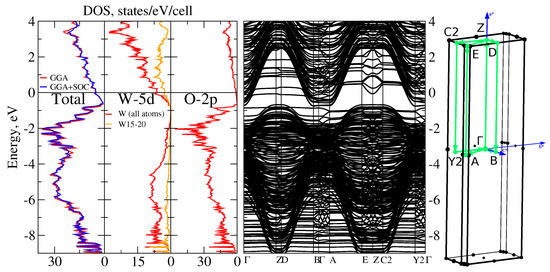
Figure 3.
Left: DFT-calculated DOS for WO — total DOS with and without SOC (left section), DOS for tungsten atoms contained in the layers of the edge-shared octahedra (middle section), and DOS for oxygen atoms (right section). Center: DFT-calculated band structure in a wide energy range without SOC. Right: Brillouin zone for WO with the /m:b space group. Zero corresponds to the Fermi level.
3. Results and Discussion
DOS and the band structure in a wide energy range for WO are shown in Figure 3. Band structure clearly shows a small gap just above eV. As is evident from DOS, the states under the gap originates mostly from oxygen while the states above the gap are mostly from tungsten. This comes from the absence of two oxygen atoms in WO as compared to the WO (equivalent to WO) band insulator system. Oxygen deficiency provides four unbound electrons which occupy the W-5d states. It can be checked by the integration of the total DOS in the energy interval from eV to 0 that gives nearly four electrons. Please note that almost three of these electrons belong to the tungsten atoms W15–W20 located along the zigzag stripe in the crystal structure (see Figure 2) while the rest of tungsten atoms have practically empty 5d shells. Those four extra electrons should occupy the orbitals, which are lowest in energy of the W-5d manifold. Introduction of SOC does not lead to any notable changes in the total DOS.
To demonstrate the importance of the tungsten atoms W15–W20, we plot their contributions to the bands near the Fermi level in Figure 4. Contributions from other tungsten atoms near the Fermi level are almost negligible. SOC does not lead to any notable changes of the bands near the Fermi level. However, the spin-orbital coupling leads to the disappearance of the electron pocket around the B point and the disappearance of two smaller electron pockets in the direction.
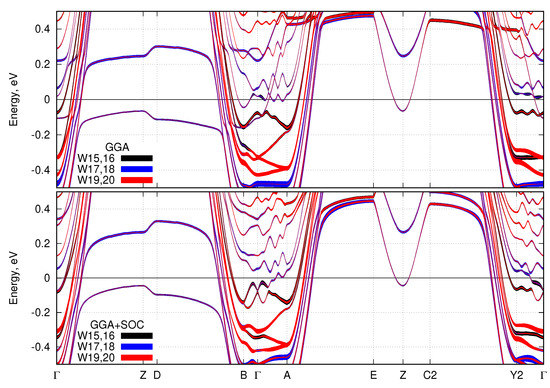
Figure 4.
DFT-calculated band structure without SOC (top) and with SOC (bottom). The orbital character of the tungsten atoms W15–W20 are shown by different colors and the width of each curve is proportional to the contribution of the corresponding orbital. Zero corresponds to the Fermi level.
On the grounds of the calculated band structure and the analysis of the orbital contribution, we propose the basis for the minimal low-energy tight-binding model. In Figure 3 and Figure 4, one can see the bands crossing the Fermi level are pretty much parabolic ones. Analysis of these parabolic bands shows that the and orbitals of the tungsten W-5d manifold of W15–W20 atoms give the dominant contribution near the Fermi level. The and orbitals become occupied because of the specific distortions of the WO octahedra within the zigzag structure described above. Since one of the basal oxygens is quite far from the central tungsten atom, those d-orbitals are less hybridized with the O-2p states and thus are shifted to lower energies, and consequently get electrons on them. Despite that the other corner-shared octahedra are also distorted (although not that much), splitting of their tungsten’s orbitals is not strong enough to allow for the occupation. Therefore, the minimal low-energy model should include just a few parabolic bands of the and orbital character.
Let us also note that these parabolic bands have a quite strong dispersion along the z-axis (Brillouin zone directions , , etc.). In particular, they form ‘bell’-shaped bands in the direction from eV to 3 eV. The top of the ‘bell’ is quite flat leading to the bunch of flat, or ‘quasi-one-dimensional’, bands seen in , , , and directions, although the WO is essentially a three-dimensional system. There are also a few bands with the dispersion in the plane, see, e.g., direction . As for the ‘wavy’ bands in the planar and directions, there is a simple explanation of their k-dependence. Due to the large number of atoms in the unit cell, there is a strong folding of the Brillouin zone in the plane. Thus, the bands in the and directions heavily intersect each other and a lot of gaps opens at the intersection points. Parabolic nature of the bands can be traced by the bare eye. By coincidence, because of the folding, there are just a few Fermi level crossings in those directions.
GGA calculated Fermi surfaces with and without SOC are shown in Figure 5a and Figure 5b, respectively. There is a bunch of one-dimensional Fermi surface sheets parallel to the plane and a couple of two-dimensional Fermi surface sheets around and points. Again, once the SOC is switched on, the electron pocket around the B point and two small electron pockets in the direction disappear. Therefore, the SOC makes the band structure just a bit simpler. Yet there are not so many bands crossing the Fermi level and, when the spin-orbit coupling is considered, the Fermi surface consists of 18 sheets with 14 of them with a quasi-one-dimensional character and the rest with a two-dimensional character.
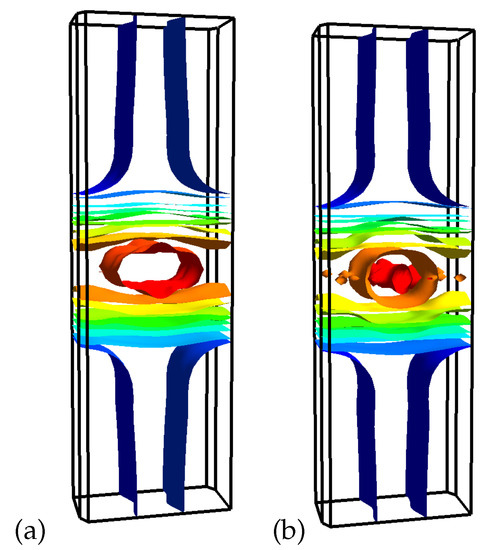
Figure 5.
Comparison of the DFT-calculated Fermi surface for WO with SOC (a) and without SOC (b).
Additional complexity of the WO system comes from the structure of the WO octahedra, i.e., they are all distorted and the O-O bond length ranges from 2.63 Å to 2.72 Å. To see what would happen for an idealized structure, we have turned all WO octahedra into ideal ones with the average O-O bond length equal to 2.68 Å [28]. Thus, the bases of all ideal octahedra create the “square lattice”. In Figure 6, we present the comparison of band structures for the real WO considered here and for the model system with the ideal octahedra from Ref. [28]. In the latter case, the main noticeable feature is the appearance of the flat bands near the Fermi level in the direction. Those bands originate from the d-states of tungsten atoms located along the zigzag stripe, see Figure 2. On the one hand, there is indeed some simplification of the electronic structure: only 6 bands per one spin projection is crossing the Fermi level in contrast to 10 for the real system without SOC. On the other hand, the Fermi surface becomes more “three-dimensional” for the idealized structure, i.e., the central part is a closed surface contrary to the distorted cylinder in the real system, see Figure 5.
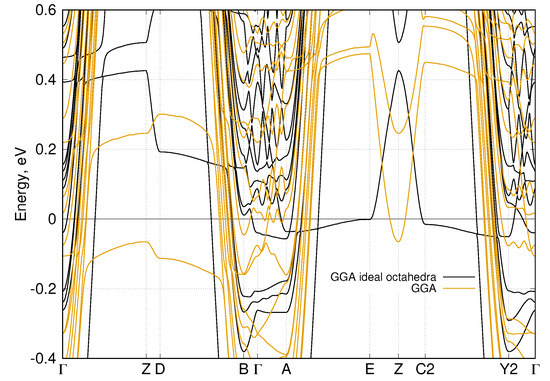
Figure 6.
Comparison of the DFT-calculated band structure for the real WO without SOC (orange) and WO with the ideal octahedra (black) [28]. Zero corresponds to the Fermi level.
4. Conclusions
We have studied the electronic structure of the non-stoichiometric material WO that is equivalent to WO via the state-of-art density functional theory in the generalized gradient approximation (GGA). The material has a sophisticated unit cell containing 78 ions thus producing an extremely complicated band structure. Bands crossing the Fermi level, however, originate mostly from the W-5d-orbitals of the small number of tungsten atoms forming the zigzag stripe pattern in the crystal structure and have predominantly W-5 and W-5 character. It is the reason the Fermi surface is quite simple. Indeed, it consists of five two-dimensional and several quasi-one-dimensional sheets. Thus, we conclude that the electronic properties of WO may be governed by the small number of W-5d-bands. This leads to a rather simple minimal model consisting of parabolic bands with and character. If the observed superconductivity involves electrons from these bands, it may explain the smallness of the experimentally estimated superconducting volume fraction.
Comparison of band structures for the real WO with and without SOC and for the model system with the ideal WO octahedra gives an unexpected result—the more complex the crystal structure, the simpler the Fermi surface. In particular, in the system with the ideal WO octahedra, the Fermi surface contains a few three-dimensional closed surfaces and a several two-dimensional ones. In the real system without the SOC, we see several two-dimensional, few quasi-one-dimensional, and only one closed three-dimensional surface. In addition, in the system with SOC, there are only a few two-dimensional and several quasi-one-dimensional Fermi surface sheets. This makes the real WO system a close relative to other quasi-two-dimensional systems demonstrating an unconventional superconductivity.
As for the possible mechanism of high- superconductivity, the conventional, electron-phonon interaction-driven, BCS mechanism is expected to give much lower ’s than those observed experimentally [3] because of the relatively low density of states at the Fermi level. On the other hand, similarity of such gross features, such as the quasi-two-dimensional Fermi surface consisting of several sheets formed by the W-5-orbitals, between WO and iron-based materials, as well as high- cuprates, may point towards the unconventional mechanism of Cooper pairing. In particular, multiband nature of the Fermi surface may result in the enhanced spin/orbital interband fluctuations, which are the main candidates for the ‘pairing glue’ in Fe-based superconductors [29,30,31].
Before proceeding to the superconductivity calculations, one must understand the effect of electronic correlations always present to some extent in transition metal compounds. First-principle scheme LDA+U can be applied to magnetic systems that is not the case of WO. Application of the LDA+DMFT approach here runs into difficulties because the structure of the unit cell is extremely complicated. Model approach seems to be the most promising and represents the next step to be done in the further studies.
Author Contributions
Conceptualization, M.M.K. and I.A.N.; calculations, A.A.S. and N.S.P.; writing, M.M.K., I.A.N., and A.A.S.; funding acquisition, I.A.N. and M.M.K. All authors have read and agreed to the published version of the manuscript.
Funding
This work was supported in part by RFBR grants No. 18-02-00281, 20-02-00011 (IAN, NSP, AAS), by RFBR and Government of Krasnoyarsk Territory and Krasnoyarsk Regional Fund of Science to the Research Projects “Electronic correlation effects and multiorbital physics in iron-based materials and cuprates” grant No. 19-42-240007 (MMK), and by the Program of Ministry of Education and Science of the Russian Federation No. 2020-1902-01-239. NSP work was also supported in part by the President of Russia grant for young scientists No. MK-1683.2019.2.
Acknowledgments
We would like to thank S.G. Ovchinnikov and M.V. Sadovskii for useful discussions. The DFT/GGA computations were performed at “URAN” supercomputer of the Institute of Mathematics and Mechanics of the RAS Ural Branch.
Conflicts of Interest
The authors declare no conflict of interest.
References
- Bednorz, J.G.; Müller, K.A. Possible high Tc superconductivity in the Ba-La-Cu-O system. Z. Phys. B Condens. Matter 1986, 64, 189–193. [Google Scholar] [CrossRef]
- Kamihara, Y.; Watanabe, T.; Hirano, M.; Hosono, H. Iron-Based Layered Superconductor La[O1−xFx]FeAs (x = 0.05 – 0.12) with Tc = 26 K. J. Am. Chem. Soc. 2008, 130, 3296–3297. [Google Scholar] [CrossRef]
- Shengelaya, A.; Conder, K.; Müller, K.A. Signatures of Filamentary Superconductivity up to 94 K in Tungsten Oxide WO2.90. J. Supercond. Nov. Magn. 2020, 33, 301–306. [Google Scholar] [CrossRef]
- Bursill, L.; Hyde, B. CS families derived from the ReO3 structure type: An electron microscope study of reduced WO3 and related pseudobinary systems. J. Solid State Chem. 1972, 4, 430–446. [Google Scholar] [CrossRef]
- Sahle, W.; Nygren, M. Electrical conductivity and high resolution electron microscopy studies of WO3-x crystals with 0 ≤ x ≤ 0.28. J. Solid State Chem. 1983, 48, 154–160. [Google Scholar] [CrossRef]
- Kieslich, G.; Cerretti, G.; Veremchuk, I.; Hermann, R.P.; Panthöfer, M.; Grin, J.; Tremel, W. A chemists view: Metal oxides with adaptive structures for thermoelectric applications. Phys. Status Solidi 2016, 213, 808–823. [Google Scholar] [CrossRef]
- Terasaki, I.; Sasago, Y.; Uchinokura, K. Large thermoelectric power in NaCo2O4 single crystals. Phys. Rev. B 1997, 56, R12685–R12687. [Google Scholar] [CrossRef]
- Kawata, T.; Iguchi, Y.; Itoh, T.; Takahata, K.; Terasaki, I. Na-site substitution effects on the thermoelectric properties of NaCo2O4. Phys. Rev. B 1999, 60, 10584–10587. [Google Scholar] [CrossRef]
- Takada, K.; Sakurai, H.; Takayama-Muromachi, E.; Izumi, F.; Dilanian, R.A.; Sasaki, T. Superconductivity in two-dimensional CoO2 layers. Nature 2003, 422, 53–55. [Google Scholar] [CrossRef]
- Ivanova, N.B.; Ovchinnikov, S.G.; Korshunov, M.M.; Eremin, I.M.; Kazak, N.V. Specific features of spin, charge, and orbital ordering in cobaltites. Physics-Uspekhi 2009, 52, 789–810. [Google Scholar] [CrossRef]
- Aird, A.; Salje, E.K.H. Sheet superconductivity in twin walls: Experimental evidence of WO3−x. J. Phys. Condens. Matter 1998, 10, L377–L380. [Google Scholar] [CrossRef]
- Kopelevich, Y.; da Silva, R.R.; Camargo, B.C. Unstable and elusive superconductors. Physica C: Supercond. and Its Appl. 2015, 514, 237–245. [Google Scholar] [CrossRef]
- Reich, S.; Tsabba, Y. Possible nucleation of a 2D superconducting phase on WO single crystals surface doped with Na. Eur. Phys. J. B Condens. Matter Complex Syst. 1999, 9, 1–4. [Google Scholar] [CrossRef]
- Shengelaya, A.; Müller, K.A. Superconductivity in Oxides Generated by Percolating Electron or Hole Bipolarons. J. Supercond. Nov. Magn. 2019, 32, 3–6. [Google Scholar] [CrossRef]
- Hamdi, H.; Salje, E.K.H.; Ghosez, P.; Bousquet, E. First-principles reinvestigation of bulk WO3. Phys. Rev. B 2016, 94, 245124. [Google Scholar] [CrossRef]
- Wijs, G.A.d.; Boer, P.K.d.; Groot, R.A.d.; Kresse, G. Anomalous behavior of the semiconducting gap in WO3 from first-principles calculations. Phys. Rev. B 1999, 59, 2684–2693. [Google Scholar] [CrossRef]
- Wang, F.; Di Valentin, C.; Pacchioni, G. Semiconductor-to-metal transition in WO3−x: Nature of the oxygen vacancy. Phys. Rev. B 2011, 84, 073103. [Google Scholar] [CrossRef]
- Mehmood, F.; Pachter, R.; Murphy, N.R.; Johnson, W.E.; Ramana, C.V. Effect of oxygen vacancies on the electronic and optical properties of tungsten oxide from first principles calculations. J. Appl. Phys. 2016, 120, 233105. [Google Scholar] [CrossRef]
- Migas, D.B.; Shaposhnikov, V.L.; Rodin, V.N.; Borisenko, V.E. Tungsten oxides. I. Effects of oxygen vacancies and doping on electronic and optical properties of different phases of WO3. J. Appl. Phys. 2010, 108, 093713. [Google Scholar] [CrossRef]
- Walkingshaw, A.D.; Spaldin, N.A.; Artacho, E. Density-functional study of charge doping in WO3. Phys. Rev. B 2004, 70, 165110. [Google Scholar] [CrossRef]
- Tosoni, S.; Di Valentin, C.; Pacchioni, G. Effect of Alkali Metals Interstitial Doping on Structural and Electronic Properties of WO3. J. Phys. Chem. C 2014, 118, 3000–3006. [Google Scholar] [CrossRef]
- Huda, M.N.; Yan, Y.; Moon, C.Y.; Wei, S.H.; Al-Jassim, M.M. Density-functional theory study of the effects of atomic impurity on the band edges of monoclinic WO3. Phys. Rev. B 2008, 77, 195102. [Google Scholar] [CrossRef]
- Migas, D.B.; Shaposhnikov, V.L.; Borisenko, V.E. Tungsten oxides. II. The metallic nature of Magnéli phases. J. Appl. Phys. 2010, 108, 093714. [Google Scholar] [CrossRef]
- Magnéli, A. Crystal structure studies on beta-tungsten oxide. Arkiv Kemi 1949, 1, 513–523. [Google Scholar]
- The Elk Code. Available online: http://elk.sourceforge.net/ (accessed on 1 December 2020).
- Perdew, J.P.; Burke, K.; Ernzerhof, M. Generalized Gradient Approximation Made Simple. Phys. Rev. Lett. 1996, 77, 3865–3868. [Google Scholar] [CrossRef]
- Hinuma, Y.; Pizzi, G.; Kumagai, Y.; Oba, F.; Tanaka, I. Band structure diagram paths based on crystallography. Comput. Mater. Sci. 2017, 128, 140–184. [Google Scholar] [CrossRef]
- Korshunov, M.; Nekrasov, I.; Pavlov, N.; Slobodchikov, A. Band structure for tungsten oxide W20O58 with ideal octahedra. Pis’ma v ZhETF 2020, 113. in print. [Google Scholar]
- Hirschfeld, P.J.; Korshunov, M.M.; Mazin, I.I. Gap symmetry and structure of Fe-based superconductors. Rep. Prog. Phys. 2011, 74, 124508. [Google Scholar] [CrossRef]
- Kontani, H.; Onari, S. Orbital-Fluctuation-Mediated Superconductivity in Iron Pnictides: Analysis of the Five-Orbital Hubbard-Holstein Model. Phys. Rev. Lett. 2010, 104, 157001. [Google Scholar] [CrossRef]
- Korshunov, M.M. Superconducting state in iron-based materials and spin-fluctuation pairing theory. Phys. Uspekhi 2014, 57, 813–819. [Google Scholar] [CrossRef]
Publisher’s Note: MDPI stays neutral with regard to jurisdictional claims in published maps and institutional affiliations. |
© 2021 by the authors. Licensee MDPI, Basel, Switzerland. This article is an open access article distributed under the terms and conditions of the Creative Commons Attribution (CC BY) license (http://creativecommons.org/licenses/by/4.0/).